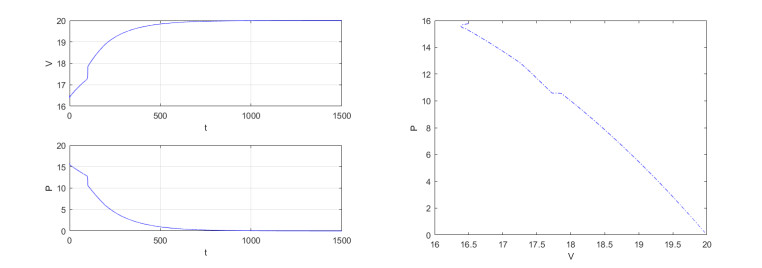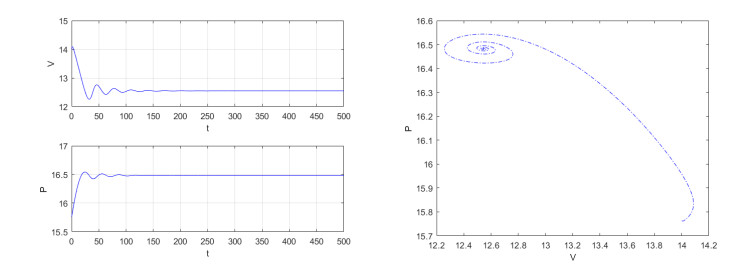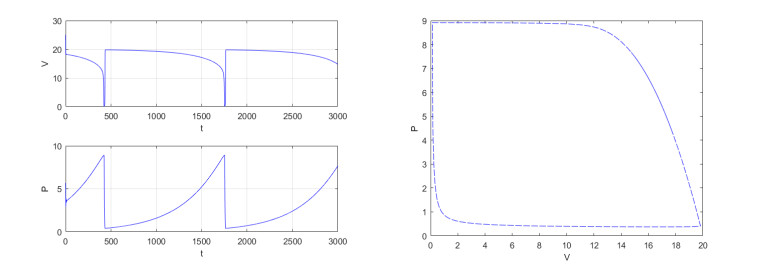1.
Introduction
This paper considers the following double-time-delay Holling Ⅱ predation model with weak Allee effect and age-structure:
The boundary conditions are
Here, V(t) and p(t,a) represent the number of predator densities at time t and age a, γ is the rate of prey' intrinsic growth, and Λ=γ+μ, where Λ is the birth and μ is the mortality rate of the prey. K indicates the maximum environmental load of prey, while σ and η indicate the predator mortality rate and the conversion coefficient of predator intake to each prey. In addition, τ1 is the time delay effect, and 0<m<K indicates the survival threshold of the food bait in the weak Allee effect. Meanwhile F(V(t))=αV(t)β+V(t) represents the Holling Ⅱ functional reaction function, where α represents the capture rate and β is a semi-saturated constant. In addition, the reproductive generation of species in the ecosystem generally takes some time to mature to have fertility, i.e., "age-dependent fertility". Fertility δ(a)∈L∞+((0,+∞),A) depends on age, for which it is often assumed that:
Assumption 1.1. Suppose that
where τ2>0,δ∗>0, and∫+∞0δ(a)e−σada=1.
It is well known that there is a long history of mathematical modeling of the interactions between predators and bait, and that different biological properties are considered in classical models, thus developing various types of predation models. Besides, there is growing evidence that functional responses play a crucial role in the interaction between predators and prey. The Gauss predation math model is given as
where, V(t) indicates the species density of the prey at time t, and P(t) indicates the species number of predators at time t. The normal constants K and γ denote the environmental capacity and inherent growth rate, respectively. d and η denote the predator mortality and the conversion coefficient of predator intake to each prey, respectively. The functional reaction function F(x) indicates the feeding rate of predators feeding on their prey.
For functional reaction functions, the earliest function form is the Lotka-Volterra type functional response F(x)=αx. This was followed by Holling Ⅱ: F(x)=αxβ+x, Holling Ⅲ: F(x)=αx2β+x2, Holling Ⅳ: F(x)=αx2β+x, and Ivlev-type: F(x)=1−e−αx. For example, a class of Leslie-Gower and Holling Ⅱ predator models are proposed in [1], which gives the global stability of the bounds of understanding, the existence of attracting sets, and the equilibrium points of coexistence:
However, in the real biological world, due to food digestion, reproduction, and other reasons, organisms need reaction time, so the time delay effect is a very important factor in many biological systems. In recent years, many researchers have studied the stability of predation models with time delay, and time delay systems, such as [2,3,4,5,6,7].
At the same time, recent literature has done extensive analysis of predator-prey models of age structure, see [8,9,10]. To study age structure models, a common method is to convert the original model to a time delay differential equation, such as [11]. Another critical method is to turn it into an abstract Cauchy problem, thus applying semi-group theory ([12,13]). In [8], Yang proposed a class of age-structure predation models containing the functional response of the Holling Ⅱ with a prey refuge:
and obtained the Hopf bifurcation of the model at the internal equilibrium point, indicating that the model has a special periodic orbit that bifurcations from the internal equilibrium point when the parameter τ exceeds the bifurcation threshold τ0. The validity of the theoretical analysis is verified by numerical simulation.
In recent years, the Allee effect in predator-prey models has also been widely studied [14,15,16,17]. The Allee effect is defined as the relationship between population size and fitness. In a predator-prey model, the impact of the Allee effect on logistic growth is expressed by including an V−m form multiplier, where m is the Allee threshold. The Allee effect is broadly divided into two categories: the strong Allee effect and the weak Allee effect [18]. The strong Allee effect indicates negative population growth when the population size is below a certain threshold. In contrast, the weak Allee effect indicates a positive population growth trend below a certain threshold. In [16], the author considered a kind of generalized Holling Ⅲ-type functional reaction, predation model with weak Allee effect, and explored the existence conditions of model equilibrium and singularity, as well as some properties of equilibrium stability:
Inspired by the above work, in this paper we will study the dynamical behavior of the predation model (1.1) of the double time-delay Holling Ⅱ functional response function with weak Allee effect and age structure.
The organization plan for this article is as follows: In Section 2, the transformation of Cauchy's problem is given, and the system well-posedness is obtained. In Section 3, the equilibrium solution of the system is studied, and the linearized system is obtained. In Section 4, the dynamical behavior of the system is studied. In Section 5, some numerical simulations and discussions are conducted.
2.
Well-posedness
First we normalize τ2 in the system (1.1), which gives
and we consider the distribution
After the wave is removed, system (1.1) becomes
where
The new function δ(a) is
and
i.e., δ∗=σe−στ2,(τ2>0).
Based on the integral semigroup theory, the suitability of the solution of system (2.1) is discussed below. For this purpose, (2.1) will be rewritten as the abstract cauchy problem(ACP). First, two lemmas about operator semigroups are introduced.
Lemma 2.1. [19,20] Let (G,T(G)) be the Hille-Yosida operator on the Banach space Y, A∈L(Y) is the set of all bounded linear operators on Y, and C=G+A are the Hille-Yosida operators.
Lemma 2.2. [19,20] Let G0 be part of the operator G on Y0:=¯T(G), defined as: G0x=Gx, where x∈T(G0)={x∈T(G):Gx∈Y0}. If (G,T(G)) is the Hille-Yosida operator on the Banach space, then (G0,T(G0)) generates a C0-semigroup on Y0.
First, let
and model (2.1) is converted to:
and
where
Further, let
then system (2.1) becomes
where
Here, we introduce the Banach space
We have the following usual product norm
Further, G:T(G)⊂Y→Y is defined as
with domain
and then
Next, we introduce the space
and define the map H:IG→Y as
where
Let h(t)=(0R2w(t)), where w(t)=w(t)(a)=w(t,a), then system (2.2) becomes
where ht∈IG,ht(θ)=h(t+θ), and h0(θ)=(0w0(θ,⋅)). Obviously this is an abstract time delay differential equation, which is further rewritten (2.3) as the ACP for applying the theory of the integral semigroup. Define y∈I([0,+∞]×[−τ1τ2,0]:Y), where y(t,θ)=h(t+θ),t≥0, and θ∈[−τ1τ2,0]. Thus, we can get the following equation:
Below we take the product of space Y and space I as the state space Z, so
and the usual product norm
Therefore, system (2.4) can be rewritten as the Cauchy problem of an abstract non-dense definition, and the linear operator T:T(L)⊂Z→Z is defined as follows:
Since Z0:=¯T(L)={0Y}×IG≠Z, we obtain that L is apparently a non-dense linear operator defined in Z. Furthermore, we take the following operator H:Z0→Z:
Finally, let z(t)=(0y(t)),y(t)=y(t)(θ)=y(t,θ). Then, (2.4) is the non-dense definition of the Cauchy problem
[19,21] studied the global existence and uniqueness of solutions containing (2.5).
Let
and then the following conclusion holds:
Theorem 2.1. For G and L, we can get:
(i) If λ∈Ω, then λ∈w(G) and
where (˜φ˜g)∈Y,(0g)∈T(G);
(ii) w(L)=w(G). Also, for the each λ∈w(L), we can obtain the explicit formula of L' resolvent
(iii) L and G are Hille−Yosida operators on Z and Y, respectively.
Proof. The first two proof methods are shown in [22], and here we only need to prove (iii). Let λ∈(−ς,+∞), then from (i) we can get
the integral for a, then
This indicates that (G,T(G)) is the Hille-Yosida operator. By the proof method in [21], we get that (L,T(L)) is a Hille-Yosida operator.
Finally, let Z0+:=Z0∩Z+, and
Since both G and L are Hille−Yosida operators, using the theory about the integral semigroup, we can get the well-posedness of model (2.5) as follows:
Theorem 2.2. There exists a unique continuous semigroup {U(t)}t≥0 on Z0+ such that for any z∈Z0+, we have that t→U(t)z is the unique integral solution for the following problem:
or
3.
Equilibrium points and linearized systems
Now we prove the existence and linearization of the equilibrium points of system (2.5). Suppose ˉz=(0Yˉχ)∈T(L) is the steady state solution of system (2.5), where
then we have Lˉz+H(ˉz)=0, that is,
The following conclusions can be obtained from (3.1):
Theorem 3.1. System (2.5) always has equilibrium:
where
In addition, (2.5) has only the positive equilibrium solution
if
where
Therefore, the following theorem holds for system (1.1):
Theorem 3.2. (i) System (1.1) always has equilibriums E0(0,0),E1(m,0),E2(K,0);
(ii) when αη>1,K(αη−1)>β, the positive equilibrium point E∗(V∗,p∗(a)) exists in the system, where
Next, we linearize system (2.5) at the equilibrium point, set ˉz as the steady state of the system (2.5), let ϖ(t)=z(t)−ˉz, and replace it with (2.5). Then,
Thus, the linearization system around ˉz is as follows:
with
and
where
According to Lemma 2.1 and Theorem 2.1, we get Theorems 3.3 and 3.4:
Theorem 3.3. L+TH(ˉz) is a Hille-Yosida operator.
Then, by Lemma 2.2, we can get the following:
Theorem 3.4. (L,T(L)),(L+TH(ˉz),T(L+TH(ˉz))) generate C0-semigroups (I(t))t≥0, (J(t))t≥0 on space Z0, respectively.
Based on the proof of Theorem 2.1, the Hille−Yosida estimate domain is ‖I(t)‖≤e−dt. Moreover, TH(ˉz)I(t):Z0→Z is clearly compact for any t>0. Then, we have
And then we can get (J(t))t≥0 is quasi-compact. According to [18], the quasi-compact related conclusion for strong continuous semigroups, when all eigenvalues of L+TH(ˉz) are negative, then for ˉd>0, when t→+∞, eˉdt‖J(t)‖→0.
Theorem 3.5. The solution semigroup T(t) of the system (2.5) satisfies the following: the solution of the steady state ˉz(t) is locally asymptotically stable (LAS), when all eigenvalues of L+TH(ˉz) have strictly negative real parts; the solution of the steady state ˉz(t) is unstable, when the presence of L+TH(ˉz) has a strictly positive real eigenvalue.
4.
Dynamics behavior
Obviously, E0 and E1 are unstable equilibrium points. Next we consider E2's stability.
4.1. Stability at point E2
4.1.1. Local stability at point E2
Theorem 4.1. When αηKβ+K<1, the equilibrium state ˉz1 of system (2.5), i.e., the equilibrium point E1(K,0) of system (1.1), is LAS; when αηKβ+K>1, E1(K,0) is unstable.
Proof. Let
where
From this, the linearized system ˉz1 can be written as
where
which is equivalent to
where ˜V(t)=∫+∞0˜v(t,a)da.
Let ˜V(t)=˜V0eλt,˜p(t,a)=˜p0(a)eλt, and substituting this into (4.1), the characteristic equations of (4.1)
Let f0(λ)=τ2ηαβKβ+K∫+∞0δ(a)e−(λ+τ2σ)ada−1. Then
Obviously, the root of g0(λ)=0 is negative, and for f0(λ)=τ2αηKβ+K∫+∞0δ(a)e−(λ+τ2σ)ada−1, we have
Because f0(λ) is strictly decreasing and satisfies continuous real functions, we have:
When ηαKβ+K−1>0, f0(λ)=0 has at least one positive root, and E2 is unstable.
When ηαKβ+K−1<0, f0(λ)=0 has no complex solution with real root and no negative, suppose that λ0=θ+ωi is the solution, so
Clearly, this is contradictory, so the solution of the characteristic equation must have negative real parts, that is, when ηαKβ+K−1<0, f0(λ)=0, and E2 is LAS.
4.1.2. Local stability at point E2
This section demonstrates the global stability of E2 using asymptotic autonomous semigroup theory.
Theorem 4.2. When ηαKβ+K−1<0, E2 is globally asymptotically stable.
Proof. From dV(t)dt of system (2.1), we can obtain
and, by the comparison principle, we have:
Therefore, for any κ>0, there exists t1 such that V(t−τ1τ2)≤K+κ, when t≥t1+τ1τ2, and then
Now, we consider the following system:
Using the same method as in Theorem 4.1, the solution of (4.2) exists in the form of ˆp(t,a)=ˆp0(a)eλ0t, where ˆp0(a) is non-negative and λ0 is the root of the characteristic equation of (4.2), i.e.,
From the second equation of (2.1), we can get
namely p(t,a)≤ˆp(t,a) for t≥t1+τ1τ2. So, p(t,a)≤ˆp0(a)eλ0t.
From Theorem 4.1, when ηαKβ+K<1, limt→∞p(t,a)=0. Thus, when t→∞, dVdt of (2.1) converges to
which illustrates that limt→∞ˆV(t)=K.
Applying the related theories from [23], we can get limt→∞V(t)=K. Hence, when ηαKβ+K<1, E2 is globally asymptotically stable.
4.2. Dynamics behavior at E∗
4.2.1. Stability at E∗
First, we need to obtain the characteristic equation of system (3.2). Let K=TF(ˉz), where ˉz represents the equilibrium state of system (2.5).
Now, we note ˉA=λI−(L+K), ˉB=I−K(λI−L)−1, ˉC=λI−L. Suppose that λ∈Ω. Because ˉC is reversible, then ˉA is equivalent to
From this, we get that
If ˉB is reversible, then
Applying Theorem 2.1 and (3.3), we can get that, for
we have
which is equivalent to
i.e.,
Let
and
then we have
From this, we can derive that
Let
From the first equation of (4.6), we can get Δ(λ)ϑ=χ1+ˉΦ(λ,χ2). That is, when Δ(λ) is reversible, we have
Thus, ˉA is reversible, i.e.,
So, Theorem 4.3 can be obtained:
Theorem 4.3. The following conclusion holds: σ(L+K)∩Ω=σP(L+K)∩Ω={λ∈Ω:det(Δ(λ))=0}, and if λ∈w(L+K)∩Ω, then the resolvents formula is
where
Proof. Because λ∈Ω with det(Δ(λ))≠0, we can get that (I−TH(ˉχ)(eλθ(λI−G)−1)) is reversible, and then from (4.5) we can get
and
Thus, ˉB is reversible for any (˜x˜χ)∈Z,
where x as shown in formula (4.8), χ=˜χ. Therefore, we obtain (4.7) and
Further, take λ∈Ω:det(Δ(λ))=0, and according to (4.3), there exists (0χ0)∈T(L),(0χ0)≠0, so
is established if and only if there exists ( ⌣ x0 ⌣ χ0)∈Z, and ( ⌣ x0 ⌣ χ0)≠0 satisfies
Let the (˜ξ˜χ) of the Eq (4.4) be equal to 0, and then we can obtain the existence of ( ⌣ x0 ⌣ χ0)∈Z∖{0} is equivalent to (4.10), where ⌣ x0=( ⌣ ϑ0 ⌣ f0) satisfies
Thus, (4.9) has solutions if and only if there exists ⌣ ϑ0≠0, so Δ(λ) ⌣ ϑ0=0, and λ∈σP(L+K). Therefore, {λ∈Ω:det(Δ(λ))=0}⊂σP(L+K).
The above analysis shows that det(Δ(λ))=0 is the characteristic equation of (3.2) about ˉz∗.
Below, we analyze the stability at E∗ and the Hopf bifurcation's existence. Due to the complexity of τ1≠τ2, only τ1=τ2=τ is considered below, and then the characteristic equation is:
where
Let λ=τϑ, then
Because of g(λ)≠0, there is
First, when τ=0, we have h(ϑ)=ϑ2+(p1+q1)ϑ+(p0+q0)=0, where p0+q0=σγ[K(αη−1)−β][β+m(αη−1)]Kmηα(αη−1)>0, hence we get the following theorem:
Theorem 4.4. When τ=0, if p1+q1>0, then E∗ is locally asymptotically stable; otherwise, it is unstable.
4.2.2. Hopf bifurcation at E∗
This section considers the Hopf bifurcation problem when τ>0. Since the age structure model studied is infinite and the central manifold theory needs to be applied to the abstract non-dense Cauchy problem, we can simplify the system considering the finite-dimensional equation on the central manifold. Thus, the Hopf bifurcation theorem of Hassard remains valid. Therefore, we will use Hassard's theorem directly below to explore the existence of the Hopf bifurcation.
Let τ>0, so the root of h(ϑ)=0 has continuous dependence on τ0. As τ increases, the root of h(ϑ)=0 can pass through the imaginary axis to the right. Let ϑ=iω(ω>0) be the purely imaginary roots of h(ϑ)=0 and substitute it into h(ϑ)=0, which gives
disassociating the real part and imaginary part,
i.e.,
and
which is
Let Θ=ω2, then above equation becomes
Due to p0+q0>0,
and, when p0−q0<0, the above equation has the sole positive root, and denote it as Θ∗. That means (4.12) has the only positive root ω∗=√Θ∗, hence h(ϑ)=0,(τ=τk) has a pair of purely imaginary roots, with
and
Lemma 4.5. In the case of Assumption 1.1 holding, when αη>1, p1+q1>0 and p0−q0<0, then
and, at this time, ϑ=iω∗ is the unique root of h(ϑ)=0.
Proof. From (4.11), we can get that
Because of h(ϑ)=0, we derive that
If dh(ϑ)dϑ|ϑ=iω∗=0 is correct, then iω∗(iq1ω∗+q0)e−iω∗τ=0, i.e., iq1ω∗+q0=0, hence q1=q0=0. Because q1=−σ<0, which contradicts the conclusion, dh(ϑ)dϑ|ϑ=iω∗≠0.
Let ϑ(τ)=ˉα(τ)+iˉω(τ) become the root of h(ϑ)=0 where ˉα(τk)=0,ˉω(τk)=ω∗. Evaluating τ on both sides of h(ϑ)=0, we get that
so
Besides,
Replace ω2∗ with Re((dϑdτ)−1|ϑ=iω∗), so
According to the correlation theorem of the Hopf bifurcation in [24], we get Theorem 4.6:
Theorem 4.6. In the case of Assumption 1.1 holding, when αη>1,K(αη−1)>β, p1+q1>0, and p0−q0<0, then
(i) when τ∈[0,τ0), E∗ is asymptotically stable, and when τ>τ0, it is unstable;
(ii) when τ=τk, system (1.1) undergoes a Hopf bifurcation at the equilibrium E∗.
5.
Numerical simulation
This section uses the MATLAB software to simulate the model numerically. First, the parameters are:
By calculating, we can get ηαKb+K−1=−0.074<0, which satisfies the condition of Theorem 4.2, that E2(20,0) is globally asymptotically stable at this time.
Let τ1=1,τ2=2. The available time series diagrams and phase diagrams are shown in Figure 1, and E2 are globally stable at this time.
Next, let the parameters become
and set V(0)=14,p(0,a)=16e−a. By calculating, we have
satisfying the condition of Theorem 4.6, and we can get τ0=3.185. First, let τ1=τ2=2. E∗(12.548,6.593e−0.4a) is asymptotically stable at this time, and the available time series diagrams and phase diagrams are shown in Figure 2. Second, let τ1=τ2=4, E∗ pass through a Hopf bifurcation. For aesthetics, we modify the initial value to V(0)=25,p(0,a)=5.395e−a. The system has periodic solutions, and the available time series diagrams and phase diagrams are shown in Figure 3.
Finally, we observe the dynamics of the system under the current parameter conditions τ1≠τ2, and let τ1=1,τ2=0. E∗ is asymptotically stable at this time, and the available time series diagrams and phase diagrams are shown in Figure 4.
As can be seen from the above analysis, the time delay effects of predation processes, energy conversion, reproductive reproduction, etc., can cause changes in the dynamics behavior of the predation system over a later period of time. At a time when the delay is less than a certain threshold, the final size of the two species is in a state of coexistence and tends to stabilize. When this threshold is exceeded, the two species still coexist, but, because the system undergoes a Hopf bifurcation, the number of the two species is subject to periodic oscillations. We know that the weak Allee effect affects the population size of the predator system by influencing its time delay threshold, which is essential for the study of the predator system.
Use of AI tools declaration
The authors declare they have not used Artificial Intelligence (AI) tools in the creation of this article.
Acknowledgments
This work is supported by National Natural Science Foundation of China Grants 12071268 and 11971281, Inner Mongolia Autonomous Region University Science and Technology Research Project NJZY22036 and by Innovation Capability Support Program of Shaanxi Province (Program No. 2023-CX-TD-61).
Conflict of interest
The authors declare there are no conflicts of interest.










 DownLoad:
DownLoad:





